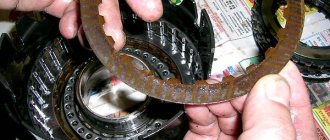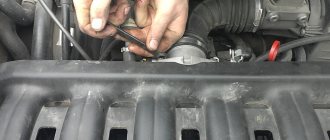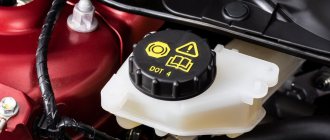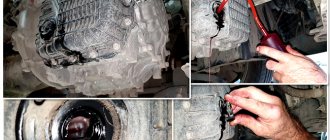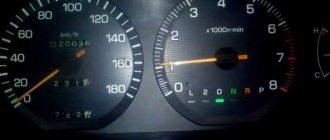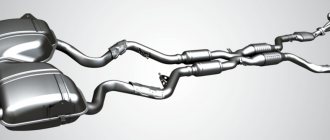Most buyers choose cars equipped with an automatic transmission. Most often this is caused by the desire to comfortably control gear shift modes without being distracted from the road. On average, automatic transmissions are designed for an operating period of at least 250 thousand kilometers. The problem - frequent slipping of the automatic transmission - can significantly shorten this period. To increase the reliability of the car and delay major automatic transmission repairs as much as possible, it is recommended to change the ATF oil more often and adhere to a measured driving style.
Causes of automatic transmission slipping
Slipping, as a rule, begins with a slow, sluggish increase in speed at maximum gas supply. As you press the gas pedal, the engine speed increases, but the car does not fully accelerate. If the automatic transmission starts to slip, it is recommended to urgently contact the nearest service company to carry out a full diagnosis of the vehicle’s automatic transmission. This defect is most often caused by a violation of the vehicle operating rules.
Why the automatic transmission slips, the first signs:
- Feeling of slipping.
- The power unit idles when upshifting.
- Slow acceleration of the vehicle.
If at least one of the listed cases is noticed in the operation of the automatic transmission, it is necessary to exclude the reasons that caused the slipping.
Automatic transmission slips, reasons:
- the level of transmission oil in the gearbox is too low;
- the condition of the lubricant has deteriorated (change in color - darkening, thick consistency, mechanical inclusions in the form of chips, fragments, fine dust, unpleasant smell of burnt lubricant);
- the integrity of the clutch elements - friction clutches - is compromised (the automatic transmission slips when cold);
- failure of electromechanical valves - solenoids (automatic transmission slips when hot);
- pressure drop in the hydraulic system due to a dirty oil pump;
- slipping of the vehicle at the beginning of movement indicates excessive clogging of the air filter;
- If you notice the automatic transmission slipping when the selector is switched to another gear, then there are malfunctions in the operation of the automatic transmission control unit.
If during the diagnostic process a drop in the volume of ATF oil or a deterioration in its condition is detected, it is recommended to flush the automatic transmission, top up or completely replace the working fluid. After washing the automatic transmission, in particular the oil channels of the valve body, using special compounds, the clutches most often stop slipping. Additionally, it is recommended to replace the contaminated filter element with a new automatic transmission oil filter.
Incorrect operation of the automatic transmission control unit can only be detected through computer diagnostics of the transmission. If deformations occur in the structure of the block, the device must be replaced with a new one. Defects not related to mechanical failures of the automatic transmission are eliminated by replacing special design cables.
A clogged air filter cannot be cleaned or washed; it must be replaced with a new device.
Important: Slipping on an automatic transmission does not always occur due to the transition to the specified gears. The quality of the lubricant also has a significant impact on the stability of the automatic transmission. It has been noticed that some brands of transmission oils lose their beneficial lubricating properties after the cold season. Experienced car enthusiasts recommend purchasing working fluids that are sufficiently resistant to low temperatures.
When not to skid
Do not try to skid on an automatic transmission if your car is one of the old monsters of the last century. Cars with high mileage suffer from severe wear of the torque converter. The transmission cooling radiator becomes clogged over time, which requires immediate replacement of the automatic transmission. If you are the owner of such a car and are not ready to give up your beloved friend, try not to go on long routes in heavy snow drifts.
If your car is “Japanese” or “European” of an old model, it may have a built-in air cooling system for the automatic transmission, while auxiliary external blades are installed on the surface of the torque converter, which circulate air to relieve the temperature. These automatic transmissions can only cool during movement, so slipping on them is contraindicated.
Conclusion 5. Modern car models from Japanese and European manufacturers with automatic transmissions do not suffer from this drawback; they will get you out of the snowdrifts without any problems.
For a true car enthusiast or an experienced professional, there are no insoluble problems on the roads. The main thing is to know your car like your own and listen to the advice of driving sages.
How is automatic transmission diagnosed?
The workshops of large service companies are equipped with special professional equipment. Diagnostic measures are carried out in several stages:
- The transmission is checked for abnormal sounds.
- Next, testing is carried out using special devices (removing car test codes).
- Analysis of identified problems.
- Drawing up a plan for preparatory and repair work.
Important: If the automatic transmission is slipping, it is not recommended to repair the identified breakdowns yourself. Especially if the car owner does not have certain technical training and knowledge in the field of automatic transmission design. Otherwise, the automatic transmission and the entire transmission will receive additional problems associated with unauthorized interference in the operation of the system.
Experienced technicians determine the nature of the automatic transmission failure based on the readings of precise diagnostic instruments. Most often, if the car cannot fully accelerate and moves only in third gear, there is a need to disassemble the automatic transmission. Only after completely disassembling the gearbox can you confidently determine the degree of complexity of the breakdown. As a rule, the main reasons for slipping of the automatic transmission lie in malfunctions of the valve body and increased wear of the automatic transmission friction discs.
Brief summary
So, if we find out that deviations in the behavior of the car are associated with slipping of the automatic transmission, you should immediately go to a trusted service station to diagnose your gearbox.
It is diagnostics that allows you to clarify the diagnosis and begin troubleshooting, knowing what exactly will have to be changed. Since the operation of the automatic transmission is controlled by its own electronic unit, diagnostics cannot be performed using standard means - you need to have the appropriate equipment and software.
Sometimes this procedure does not reveal problems, and after replacing the TM and oil filter, the operation of the transmission returns to normal. But if there are symptoms of gear wear, then in most cases you have to solve the problem by completely disassembling the unit. In particular, this cannot be avoided if the valve body is faulty or if the friction rings are faulty.
It is impossible to estimate the budget for repair work in advance, since everything depends on the specific malfunction, and several of them may be discovered during the repair of the box.
Don’t be surprised if it turns out that even the operation of changing transmission oil will cost much more than when changing the oil in the power unit - the complexity of this operation is corresponding, which has a decisive influence on pricing.
The appearance of slipping symptoms indicates that problems already exist, and repairs most likely cannot be avoided. But if you strictly adhere to the automaker’s recommendations regarding the operation and maintenance of an automatic transmission, then you can be sure that the gearbox will serve you no less than the stated period. This means that you will be able to do without expensive repairs, which are unlikely to be carried out on your own.
Faulty valve body as a cause of automatic transmission slipping
As mentioned above, often the cause of automatic transmission slipping is incorrect operation of the automatic transmission valve body. Malfunctions of this nature are caused by excessive clogging of the oil channels. This means that the working elements of the gearbox do not receive sufficient lubrication, resulting in the effect of clutch slipping. This problem is solved by cleaning the oil channels of the hydraulic plate, followed by replacing the lubricant and oil air filters of the vehicle.
Cleaning of the hydraulic unit is carried out in special service centers where the necessary equipment is installed. Among modern methods, services such as cleaning the automatic transmission valve body using special compounds, as well as ultrasound, are becoming increasingly popular. Using modern technologies used in the automotive repair industry, clogged channels are cleared, eliminating the need to replace an expensive valve body. The procedure often takes a long time to complete, with the labor-intensive process lasting several working days. Reason: to clean the oil lines of the vehicle’s hydraulic system, it is necessary to remove the hydraulic unit from the vehicle.
I engaged reverse gear at speed - WHAT WILL HAPPEN? Let's look at automatic transmission and manual transmission
A transmission is a part of a vehicle that takes on heavy loads during a trip. That is why, during its design, much attention was paid to the reliability of the constituent elements. The first problems with this unit may arise after 80,000 km, for example, the reverse gear stops engaging. This manifestation at an earlier time period is possible if the car owner did not take care of the automotive system. In particular, maintenance was neglected and transmission fuel of inadequate quality was used.
Main problems with automatic transmission:
- Unexpected decrease in oil level in the box. This usually means a violation of the integrity of the block and automatic transmission pipes; the oil simply leaks out. To eliminate it, you need to find the extra hole and remove it. This is usually a leaky or outdated pipe. Over time, the gaskets may burn out.
- One or more gears have stopped turning on.
This can happen for three reasons: there is not enough oil to operate the box, the mechanisms of one of the transmissions have failed, or the control unit is broken. To fix it, you need to diagnose it and make the necessary repairs. If the problem is with the fluid level, you need to top it up, the machine will start working normally. Things could be worse - the torque converter could also fail. - The car doesn’t move at all, it skids in place, but there is reverse gear. The reason is wear of the friction discs or clutch. To fix it, you will have to open the box and perform a visual diagnosis of the condition of the units.
- The opposite situation: the car goes anywhere, but not back, 3 and 4 speeds do not work.
This could also be caused by wear of the friction discs, breakage of the piston cuff, breakage of their wheels, or damage to the spline connection. To fix it you will have to disassemble the box. - All speeds work except the reverse - wear of the brake band, cuff or piston rod. To eliminate it, it will be necessary to replace all failed elements.
- The car is stationary, the gear shift is not felt. Here the reason is unclear: lack of oil, failure of the friction discs and their pistons, and even breakdown of the torque converter.
- There are shifting shocks, but the car is slipping.
Lack of oil, torque converter failure, clogged oil filter. To fix it, you should start from simple to complex, namely, check the oil level and remove the filter. The torque converter may not lock up. - Slipping when starting off. The torque converter is worn out and its shaft is slipping, or the forward clutch clutches are worn out. To eliminate the unpleasant situation, you will need to open and diagnose the box.
- The car moves from a standstill in the neutral position.
One of the pistons is stuck, the discs are welded, or the control lever adjustment is broken. - Grinding and humming in the box, vibration are symptoms of wear of the mechanisms; an inspection is necessary here. The locking of the torque converter could well have disappeared.
- The car drives only after warming up. The reason is wear of the friction discs.
- The car does not develop speed and does not climb hills well. These are engine faults, not gearbox faults, but a visit to the service station is also required.
- The car stalls at speed.
The valves are stuck or the torque converter is malfunctioning; detailed diagnostics are needed. - Presence of brown-white foam. There is water in the automatic transmission unit, the automatic transmission is clogged with dirt, there is not enough oil, the pressure valve is stuck.
Worn automatic transmission gear
Any incomprehensible behavior of the box should never be ignored! The reason may not be serious, but driving a car with a faulty automatic transmission is dangerous and can cost the owner dearly.
Next, let's take a closer look at the main problems with automatic transmissions in popular cars.
How does an automatic transmission work in a car?
An automatic transmission uses a hydraulic system to select the desired gear. All such manipulations in automatic transmissions involve the use of fluid as a component that transmits forces. The “intelligent” work, recognizing when it is necessary to switch to another stage, is carried out by the control unit and the control unit.
https://www.youtube.com/watch?v=Z3ck1MSxpeM
The driver in a car with an automatic transmission uses a selector mounted in the interior to engage reverse gear, park or drive mode. This lever acts kinematically on certain elements of the box. The automatic unit consists of the following modules:
- torque converter;
- gearbox with planetary gears;
- hydraulic control unit.
The clutch is not present in a classic form in such cars. Its functions are performed by a torque converter. Thanks to this element, torque is transmitted from the power plant to the transmission. The design of the GTF differs significantly from the clutch in a manual transmission, since due to its features it is capable of increasing the transmitted force due to the presence of fluid.
The planetary gearbox receives torque from the torque converter. Next, the force is distributed to the drive axle. The node is also capable of varying the value, increasing or decreasing the coefficient, based on the current driving conditions of the vehicle.
The hydraulic control system uses solenoids to open and close the valves. In this way, the transmission fluid acts on certain brake units and transmission clutches. In offline mode, the gears are locked or unlocked, which allows you to move to the desired level.
In previous generations of automatic transmissions, the automatic transmission was exclusively hydraulic. Later installations respond to commands from the electronics, which control the solenoids, based on the current values of the power plant speed, vehicle speed, transmission temperature conditions and other indicators.
Ford Focus. Automatic transmission 4f27e
Installed on Ford Focus and Mazda 3. Not a very reliable box. The 4f27e has weak points: belt, automatic transmission cover, brake drum, clutch basket, solenoid. Unlike simple and reliable mechanics, the Ford Focus uses a less reliable 4f27e planetary automatic transmission.
Let's consider a specific case. Symptoms On a 2008 Ford Focus, first the 4th gear disappeared, then the 3rd too. After reaching first gear and engaging second, the 4f27e goes into neutral and the Ford Focus stops.
Automatic transmission 4f27e installed on Ford Focus
What is the possible reason for this behavior of the 4f27e box? Often the 4f27e is equipped with a low-quality solenoid, which can fail and jam. Their defect on 4f27e boxes is determined by the diagnostic system. In this case, the solenoid on the Ford Focus box is replaced.
In early versions of the 4f27e, there is a specific defect in the automatic transmission cover, due to which the pressure in the Ford Focus transmission is greatly lost. In this case, it is necessary to open the box (this is possible without removing it) and change the cover. If the box worked in emergency mode for some time, this could lead to failure of its individual mechanisms, which will require replacement. Which is what was done in this case.
If any of the gears fails, this indicates a breakdown of the friction disc, and the color of the oil on the 4f27e changes. This happens at 100,000 km for a Ford Focus.
The absence of reverse gear or its activation with a delay, as well as a change in the color of the oil, indicates wear of the reverse gear friction disc. Ford Focus from 4f27e 2008 sometimes has a factory defect, which leads to wear of the damper spring and failure of the clutch and the need to replace it.
Noise at speed, jerks and shocks when shifting gears, as well as vibration when driving indicate the cause of gear wear, malfunction of the torque converter (donut) or lack of oil. After detecting such faults, the Ford Focus should be taken in for diagnostics.
Below is a video that shows in some detail how a Ford Focus automatic transmission is disassembled if it needs to be disassembled to fix a malfunction.
Mechanics (manual transmission)
In order to understand that you will not kill your manual transmission, you just need to try to engage reverse gear while driving.
There will simply be a deafening crunch, and the transmission will not want to engage. No matter how many times you try to install it.
The thing is that the lever on the mechanics is rigidly connected to the gear shift fork(s). When moving forward, the shafts (primary and secondary, possibly intermediate) rotate in a certain direction. To engage reverse, you need to make them rotate in another, absolutely opposite direction (which is possible), BUT it’s very difficult! Only after a complete stop, it is easy and simple to do this and they will go in a different direction.
Another point is that the reverse gear does not have a synchronizer (in fact, it does not need one), and therefore the gear is engaged only from a standing position. Therefore, a wild crunch will be heard.
Mitsubishi Pajero Sport
The Pajero Sport and Delica models are equipped with gearboxes manufactured by Toyota.
Peculiarities. On Pajero, the oil level in the automatic transmission is measured only in the neutral position. In position P, the fluid level will appear to be higher. The oil filter on the Pajero Sport automatic transmission is disposable; they always need to be changed, even with a partial oil change. The weak resource of the lockup (when it is activated, the fluid coupling is blocked) in the Pajero Sport leads to the destruction of the mechanism and its clogging with automatic transmission parts. It is noteworthy that these automatic transmissions are more demanding in terms of oil selection than the same ones found on Toyotas.
Mitsubishi Pajero Sport with automatic transmission
Automatic transmission malfunctions on Pajero Sport:
- Slipping;
- Automatic transmission emergency mode;
- Vibration;
Jerks and delays when switching.
Why won't reverse gear engage? Causes and solutions
The transmission is the most mysterious unit in a car, especially for people who are not technically savvy. And everything seems simple - you squeeze the clutch, push the handle and the car goes. However, if suddenly it doesn’t go, then you don’t know what to think. Therefore, when something happens to the gearbox - reverse gear does not engage, for example, then at least cry.
And if it happens in a garage or in a parking lot, where there are always a lot of advisers who always know exactly why the gear won’t engage, then after several minutes of heated discussions you begin to regret that the gearbox in the car is not an automatic, but a manual transmission. Although automatic transmission is also not without such problems. But let's start in order.
So, reverse gear does not work, what should I do? Well, for starters, it would be nice to figure out how serious the damage is. To do this, you need to remember how the box behaved in recent days. If nothing has caused concern, then there is hope that not everything is so bad: the transmission is still a complex and reliable element, with a large margin of safety - and it doesn’t just break out of the blue. If reverse gear does not engage, there may be several reasons. We will move from simple to complex.
Wear of the rocker bushing
This malfunction may be indicated by some looseness of the lever. However, if the wear proceeded evenly - it ran its course - you could get used to the free movements of the scenes and not notice the impending troubles. The problem is solved by replacing the bushing - remove the lever cover, then remove the rocker itself, replace the plastic bushing with a new one and put everything in place. The procedure is carried out in the car interior.
Electrical faults
Some car models use electromagnetic locking when engaging reverse gear. The wires dangle carelessly under the bottom of the car. In our conditions, this is unforgivable negligence, because the wires rot or are damaged. As a result, there is no bow and you can’t get the speed up.
Mechanical damage or blocking of gearbox rods
For some vehicles, the location of the gearbox involves the use of external gear shift rods. In bad weather - when there is ice, dirt or snow sticking to them, their free movement can be difficult, especially for reverse gear, because it is not used often, but is turned on first in the morning.
Source: https://td-ama.rf/remont/propala-zadnyaya-skorost-na-akpp.html
Automatic transmission slipping due to worn solenoids
Simultaneously with cleaning the hydraulic plate, all filter elements of the vehicle are replaced, and the ATF transmission oil in the automatic transmission is also changed. Electromagnetic bypass valves - solenoids - are also subject to mandatory replacement. Even the highest quality automatic transmission solenoids quickly fail when using old lubricant or low quality oil. Before changing the solenoid valves, the pressure in the lubrication system is measured. Using simple measurements, experienced craftsmen determine the degree of complexity of solenoid failures.
Is it possible to skid on an automatic transmission (how to move off correctly if stuck in a snowdrift)
Many beginners ask the question “why you can’t skid.” What to do with a car stuck in a mud rut. Experts answer this question that in rare cases it is possible to slip, but not often and without fanaticism.
For a car with front-wheel drive, rear-wheel drive or all-wheel drive, there are rules. Which should not be neglected.
Front-wheel drive
On front wheel drive vehicles the rules are as follows:
- Do not use the selector lever position "Forward" or "D". This will lead to gear shifting in accelerated mode and the automatic transmission will experience heavy loads. But the car will remain in place.
- Place the machine in low gear or “L” mode. Set the first or second speed. Try to get out of the snowdrift using these gears.
- If you can’t move the car, it’s better to call someone for help to push the vehicle or pull it out with a second car.
Read
Typical problems and repairs of automatic transmission f4a42
Experts recommend keeping the wheels straight and putting something under them. It is advisable to use boards under the front wheels. The car will have a stop, and it will be able to drive out without strain.
Rear drive
Many car owners do not know how to properly drive out of a mud rut or snowdrift if the vehicle has rear-wheel drive. There are no big differences with front-wheel drive.
Only, if the car owner will use objects to place under the wheels in order to drive out, then it is advisable to place them under the rear tires. Since a vehicle with rear-wheel drive is driven by the rear wheels.
Four-wheel drive
SUVs with all-wheel drive are also not designed for long periods of slipping. The car will slip in snowdrifts and on muddy roads, but the automatic transmission will not last long.
Since the weight of a passenger car is 1 ton, and an SUV weighs 3 tons. Therefore, the load on the machine is large. It can fail faster after a few slips, while a car with an automatic transmission can withstand another ten.
Read
What is the difference between rights to an automatic and rights to a manual?
Therefore, the answer to the question whether it is possible to slip on SUVs with all-wheel drive is an unequivocal no. Experts say that if you accidentally drive into a snowdrift or a mud rut, you can still drive in by skidding. But it is not recommended to specifically participate in mud rallies.
Automatic transmission slipping due to burnt clutches
In order to completely get rid of automatic transmission slipping, many service companies conduct thorough diagnostics of friction connections. The basis for concern is the reduced durability of the friction linings of the clutch discs. During the operation of the vehicle, soft friction discs wear out most quickly, become unusable and cease to perform their functions.
As a rule, disc wear occurs after a mileage of 250–300,000 km. After the car has passed this route, it is necessary to completely change the automatic transmission clutches. The procedure for replacing friction elements is a complex, time-consuming undertaking. It is not recommended to carry out such work at home.
Attention: Prolonged operation of a vehicle with burnt clutches will lead to increased automatic transmission slippage and further expensive overhaul of the gearbox and power unit.
Untimely replacement of ATF transmission oil in an automatic transmission entails prolonged towing of the automatic transmission followed by expensive repairs. Premature wear of friction linings causes great harm to transmission oil, filter elements, and has an adverse effect on the general technical condition of the automatic transmission and transmission as a whole.
The friction discs included in the kit are part of the clutch mechanism for the working gears of each gear. If slipping is noticed when the selector is switched to any gear (for example, automatic transmission slipping from 2 to 3), you can understand where the friction clutch is damaged.
Why is my manual transmission slipping?
The standard (manual) transmission also uses fluid, but leaks are not a common problem; A standard transmission can lose all its fluid and never slip, although it will eventually lock up while driving down the road. If you have a standard transmission and it is slipping and not getting power to the wheels, the problem is usually the clutch.
Later in the article I discuss how to diagnose this problem.
Friction disc replacement technology
If the car owner has sufficient experience in carrying out such operations, you can replace the clutches in the automatic transmission with your own hands in a garage. The room where the work will be carried out is thoroughly cleaned of any remaining dirt and dust accumulations. To successfully carry out repair and restoration work, an appropriate repair kit is selected that is suitable for a specific vehicle equipped with an automatic transmission:
- Friction disc set.
- Seals, seals, gaskets.
- Filter elements.
Sequence of work:
- removing transmission oil from automatic transmission;
- dismantling the box from the car;
- disassembling the gearbox;
- replacement of all elements included in the prepared repair kit;
- Assembling the automatic transmission, the steps are performed in the reverse order;
- installing an automatic transmission on a vehicle.
What to do if your automatic transmission is low on fluid
Next question: why? Probably because you have a leak. You may have noticed red transmission fluid in your driveway or in a parking space at work, but it didn't occur to you that it was leaking from your car. The cause of your leak is likely a failure in one of the seals that keep the oil inside the transmission (although there are other places where the transmission can leak). How many seals the transmission has depends on whether you have a front-wheel drive, all-wheel drive, or rear-wheel drive vehicle.
If you have a leak and you catch it in time before it damages your transmission, chances are it could be relatively cheap to fix. The seals themselves are not expensive parts, but depending on where they are located, they can require a lot of labor to replace.
The influence of the electronic control unit (ECU) on automatic transmission slippage
Incorrect functioning of the automatic transmission control unit is also the cause of machine slipping. The problems lie in the failure of ECU elements. Most often, a decision is made to completely replace the entire automatic transmission control unit.
Despite the fact that diagnosing this problem is not very difficult, it is not always possible to carry it out at home. It is best to contact a specialized center equipped with special diagnostic devices. The cost of services for identifying and troubleshooting the electronic control unit differs; it depends on the price of a car with an automatic transmission.
Doesn't change to another mode
It happens that the “automatic” does not allow you to switch the selector to another mode, no matter how hard you try. This also includes blocking the operation of one of the gears. What to do about it, you ask. First, stop, call a tow truck and take the car to a service center. There, experts will examine the automatic transmission and give their verdict.
You may need to replace the rocker. It is found mainly on old-type automatic transmissions, which have a mechanical connection with the selector. Such a breakdown leads to difficulty switching the selector or to its complete blocking. It all depends on the mechanics of the damage. Repairs can cost different amounts, since in some cars the linkage can be replaced without removing the automatic transmission, while in others it will be necessary to dismantle it. This will make a big difference in price and repair time.
Another cause of mode switching problems may be the control unit. In case of problems, it can block the operation of the “machine” or its individual modes. This problem is solved by replacing individual blocks and loops or the entire electronic control unit. Such repairs will cost much more than replacing the rocker, but there is no escape - you simply will not be able to drive such a car.
Stages of diagnosis
Automatic transmission diagnostics can be divided into the following stages:
- The stage of establishing visible and, most importantly, audible problems. This is the first and fastest type of diagnosis of automatic transmission faults, which the car owner himself can do and, based on assumptions about problems, contact a specialist.
- Stage of medium level of complexity, so-called tangible. This diagnosis can only be carried out by a specialist, since it directly involves reading codes, various autotests, and then establishing a “diagnosis”.
- The repair stage, which is resorted to after the first two stages. It begins after slipping has been diagnosed and can ONLY be carried out by a highly qualified automatic transmission repair technician. Otherwise, you can completely ruin your car and significantly increase the possible costs of repairing it. This stage is most often necessary when the car is already in poor condition (driving in 3rd gear) or when the clutches are slipping. In all of the above cases, disassembling the automatic transmission is necessary. Only this procedure will help you determine with 100% accuracy both the type of breakdown and the method of repairing it.
